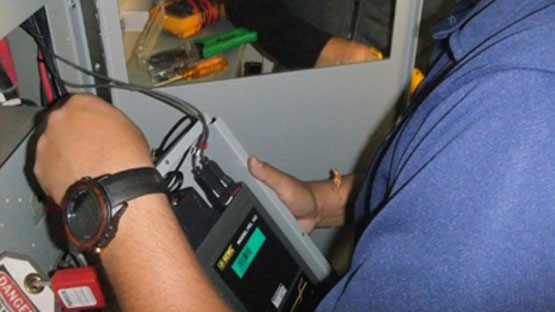September 18, 2023
One of the best ways to increase energy efficiency is to map out how it is used and look for opportunities to cut back. But with a system as complex as a Navy vessel, it’s nearly impossible to do without potentially compromising the ship’s operations. One work around is to create a digital twin: a digital version of the ship that allows researchers to analyze energy use trends, and see what happens when energy-efficiency tools and methods are optimized.
Dr. Gisele Amow, a defence scientist with Defence Research and Development Canada (DRDC), is doing just that. She has been leading a project called the Ship Platform Exploitation of Energy Datasets (SPEED 2.0). The project’s goal is to produce expert advice and tools to reduce greenhouse gas emissions while maintaining or even increasing ship operational capability.

Naval Engineering Test Establishment (NETE) personnel install one of 67 electrical load meters on the HMCS Charlottetown, for the SPEED 2.0 research project. These meters will help with understanding the baseline energy use of the ship.
With $750,000 in funding from the Greening Government Fund over two years and building on a previous project, SPEED 2.0 will run until 2025. The SPEED 2.0 project team includes researchers from DRDC, Natural Resources Canada (NRCan)’s CanmetENERGY and the National Research Council of Canada (NRC).
The project’s goals are:
- To understand baseline energy use (electrical, heating and cooling loads) when the ship performs various operations and goes through different environmental conditions
- To develop ship energy models using physics-based and machine learning approaches
- To explore developing ship-energy “digital twins” that will allow for decision-making on energy efficiency
The “digital twin” will allow decision-makers to try out different scenarios and tools to make sure they indeed reduce energy use and greenhouse gases while maintaining operational capability. For example: does a tool designed to reduce energy use end up compromising operations? Does a tool meant to optimize a route compromise operations? Understanding these in a digital space means testing without hindering a ship from doing its work – and producing a solid idea of how those tools and methods would work in the real world.
SPEED 2.0 is being conducted in close cooperation with DRDC’s partners within DND. The findings of the project could eventually be applied across the entire federal maritime fleet, including Transport Canada, the Royal Canadian Mounted Police and the Canadian Coast Guard.
